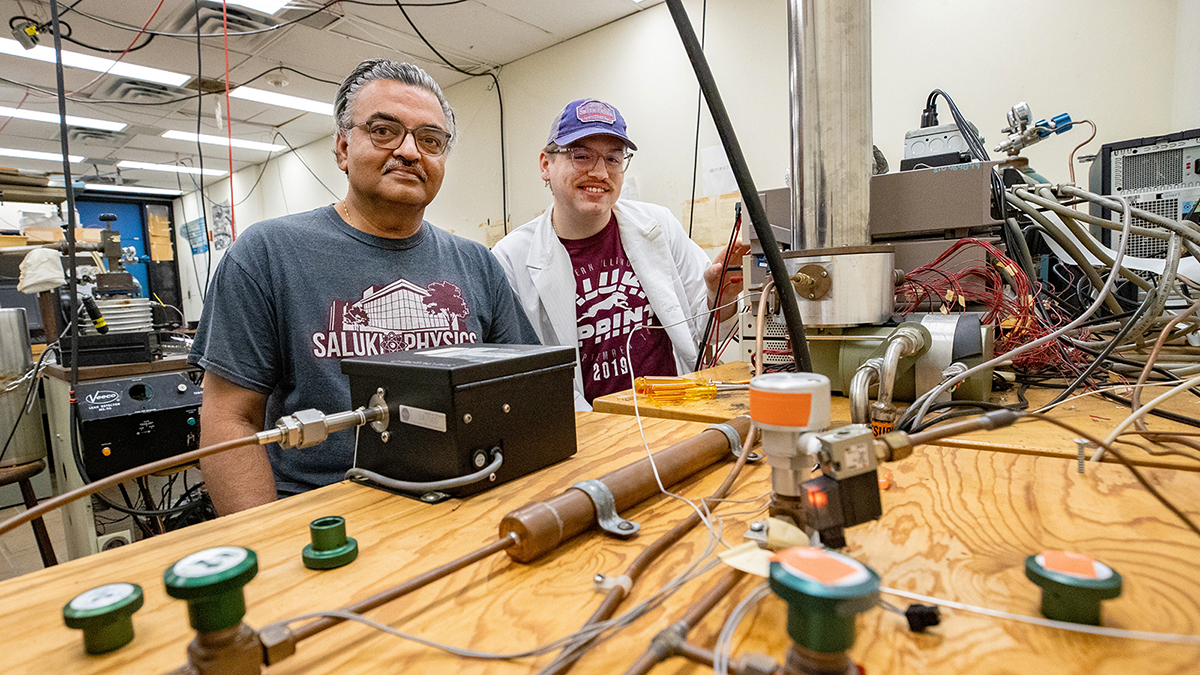
Saikat Talapatra, left, professor in the School of Physics and Applied Physics, and Nathanial Smith, a graduate student from Decatur, work in Talapatra’s laboratory at SIU. Talapatra has received a Fulbright fellowship to develop CO2-capture materials made from agricultural waste products in India. (Photo by Russell Bailey)
July 01, 2025
SIU prof seeks to transform ag waste into ‘holy grail of CO2 capture’
CARBONDALE, Ill. – A researcher at Southern Illinois University Carbondale wants to use agricultural waste products to develop carbon materials specifically designed to trap carbon dioxide, and he has earned a prestigious Fulbright-Nehru Academic and Professional Excellence Fellowship to pursue the work with colleagues in India.
Saikat Talapatra, professor in the School of Physics and Applied Physics, has received a Fulbright U.S. Scholar award to coordinate with the Indian Institute of Technology Kharagpur, one of that country’s oldest and world-renowned institutes and one that specializes in synthesizing sustainable carbon-based materials. Because of its focus, the labs at IITK include many of the specific scientific instruments needed to advance the work, making it an ideal partner, Talapatra said.
Talapatra hopes to expand on the concept of trapping gases on carbon-based porous nano materials, a topic he explored as a doctoral student at SIU as far back as 2002. The technology can be used in gas sequestration, separation or in sensor-based platforms.
In this case, Talapatra will be working with the biowaste produced by rice farming, one of India’s biggest agricultural sectors and possibly the largest such producer in the world. The researchers will investigate adsorptive surface properties of porous carbon materials obtained from bio-waste products from rice farming and develop them for CO2 capture and storage.
With the fellowship scheduled to begin in October, Talapatra can take up to two years to complete his work, which aims to establish the feasibility of such materials. If successful, the materials could be used in the real world in so-called “direct-air capture” settings, though recent research suggests this could be challenging.
“That would be the holy grail of CO2 capture,” Talapatra said. “But there could be other uses of these materials, if we develop them properly, that, for example, could be used in greenhouse gas removal, gas separation, methane storage and other forms of applications in energy and environment-related fields.”
An example of first-rate research
Costas Tsatsoulis, vice chancellor for research and dean of the graduate school at SIU, said Talapatra’s Fulbright fellowship is one more affirmation of his world-class research work in the field of materials physics.
“As a Carnegie Research 1 institution, SIU is proud to support the research activities of such outstanding faculty,” he said.
Boyd Goodson, professor and distinguished scholar and associate dean in the College of Agricultural, Life and Physical Sciences, said Talapatra’s work is exciting for its CO2-trapping potential.
“He is highly deserving of this prestigious international award, given in recognition of both his research and his leadership,” Goodson said. “It serves as yet another indication of the world-class faculty and research programs we have in CALPS and at SIU in general.”
Opportunities to advance science, partnerships
Talapatra said he has high hopes for the technology, which is evolving quickly.
“With innovations in advanced synthesis techniques and, I think, a better understanding of gas adsorption behavior on carbon surfaces, we can look at using this technology geared toward positively affecting global climate change,” he said. “The opportunity lies in producing these materials from waste products specifically tuned to trap CO2.”
His partner on the project in India, Professor Chandra Sekhar Tiwari, has developed processes that can lead to such materials, Talapatra said. One of the key challenges, however, is designing the carbon surfaces that can adsorb CO2 at or near room temperature.
“Then the question will be: How much can we store?” he said.
The group also may face other unforeseen and challenging scenarios, such as machine maintenance, supply chain issues and international travel-related complications.
“You never know, but hey, I am an experimentalist, I am always optimistic about most of the things in life,” Talapatra said. “So, I think we will get to most or all of our projected deliverables.”
In today’s rapidly changing global landscape of advanced scientific research and exploration, collaborations and scientific partnerships play an important role, Talapatra said. While at SIU, he and others have created a strong worldwide research network.
“I view this opportunity as a new beginning for bridging the gap between the research cultures of these two countries,” he said. “We hope to provide opportunities to spread the word about the U.S. education system – and why it’s one of the best in the world – perhaps through seminars and colloquiums in neighboring institutions and high schools. One of the goals, other than the proposed research, is to see if we can develop some long-term ties with the host institution and others in India through student exchange and visiting programs.”
Fulbright is a long tradition
Fulbright scholars are faculty, researchers, administrators and established professionals engaged in cutting-edge research and expanding their networks. They often continue research collaborations started abroad and lay the groundwork for future partnerships between institutions.
Since 1946, Fulbright, a program of the U.S. Department of State, has provided over 400,000 scholars with the opportunity to study, teach and conduct research in more than 160 countries.
Talapatra’s Fulbright fellowship covers living expenses in the host country, some travel expenses and modest research-related expenditures.
“I am extremely grateful for the funding received and strongly support the idea of providing resources for advancing basic sciences,” he said. “But money is not the point here. The opportunity this fellowship provides is priceless,” he said.
